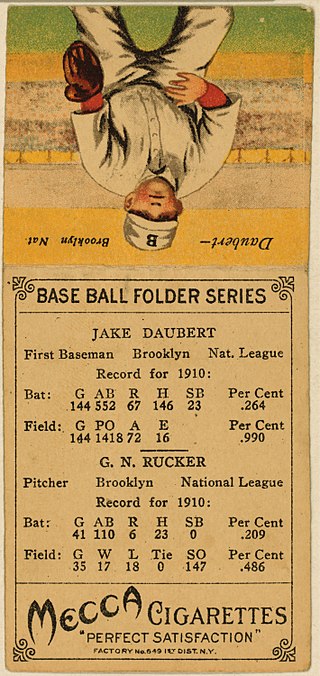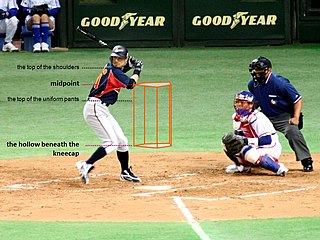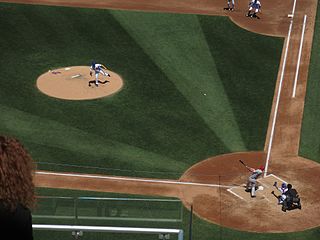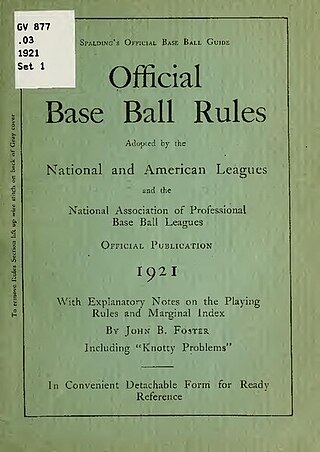Related Research Articles

Baseball statistics include a variety of metrics used to evaluate player and team performance in the sport of baseball.

A base on balls (BB), better known as a walk, occurs in baseball when a batter receives four pitches during a plate appearance that the umpire calls balls, and is in turn awarded first base without the possibility of being called out. The base on balls is defined in Section 2.00 of baseball's Official Rules, and further detail is given in 6.08(a). Despite being known as a "walk", it is considered a faux pas for a professional player to actually walk to first base; the batter-runner and any advancing runners normally jog on such a play.

In baseball, hit by pitch (HBP) is an event in which a batter or his clothing or equipment is struck directly by a pitch from the pitcher; the batter is called a hit batsman (HB). A hit batsman is awarded first base, provided that he made an honest effort to avoid the pitch, although failure to do so is rarely called by an umpire. Being hit by a pitch is often caused by a batter standing too close to, or "crowding", home plate.

Baseball is a bat-and-ball sport played between two teams of nine players each, taking turns batting and fielding. The game occurs over the course of several plays, with each play generally beginning when a player on the fielding team, called the pitcher, throws a ball that a player on the batting team, called the batter, tries to hit with a bat. The objective of the offensive team is to hit the ball into the field of play, away from the other team's players, allowing its players to run the bases, having them advance counter-clockwise around four bases to score what are called "runs". The objective of the defensive team is to prevent batters from becoming runners, and to prevent runners advancing around the bases. A run is scored when a runner legally advances around the bases in order and touches home plate.

In baseball, the strike zone is the area of space through which a pitch must pass in order to be called a strike even if the batter does not swing. The strike zone is defined as the volume of space above home plate and between the batter's knees and the midpoint of their torso. Whether a pitch passes through the zone is decided by an umpire, who is generally positioned behind the catcher.

Softball is a popular variation of baseball, the difference being that it is played with a larger ball, on a smaller field, and with only underhand pitches permitted. Softball is played competitively at club levels, the college level, and the professional level. The game was first created in 1887 in Chicago by George Hancock.

Backyard cricket, also known as bat ball, street cricket, beach cricket, corridor cricket, garden cricket, gully cricket and box cricket, is an informal variant of cricket. It is typically played in various non-traditional venues such as gardens, backyards, streets, parks, carparks, beaches, and any area not specifically designed for the sport.

In baseball, the pitcher is the player who throws ("pitches") the baseball from the pitcher's mound toward the catcher to begin each play, with the goal of retiring a batter, who attempts to either make contact with the pitched ball or draw a walk. In the numbering system used to record defensive plays, the pitcher is assigned the number 1. The pitcher is often considered the most important player on the defensive side of the game, and as such is situated at the right end of the defensive spectrum. There are many different types of pitchers, such as the starting pitcher, relief pitcher, middle reliever, lefty specialist, setup man, and the closer.

Baseball Stars is a 1989 baseball video game developed and published by SNK for the Nintendo Entertainment System. It was also released in arcades by Nintendo through their PlayChoice-10 arcade system.

In baseball, an intentional base on balls, usually referred to as an intentional walk and denoted in baseball scorekeeping by IBB, is a walk issued to a batter by a pitcher with the intent of removing the batter's opportunity to swing at the pitched ball. A pitch that is intentionally thrown far outside the strike zone for this purpose is referred to as an intentional ball.

A four-seam fastball, also called a rising fastball, a four-seamer, or a cross-seam fastball, is a pitch in baseball. It is a member of the fastball family of pitches and is usually the fastest ball thrown by a pitcher. It is called what it is because with every rotation of the ball as it is thrown, four seams come into view. A few pitchers at the major league level can sometimes reach a pitch speed of over 100 mph. It is often compared with the two-seam fastball.

In baseball, the batting order or batting lineup is the sequence in which the members of the offense take their turns in batting against the pitcher. The batting order is the main component of a team's offensive strategy. In Major League Baseball, the batting order is set by the manager, who before the game begins must present the home plate umpire with two copies of his team's lineup card, a card on which a team's starting batting order is recorded. The home plate umpire keeps one copy of the lineup card of each team, and gives the second copy to the opposing manager. Once the home plate umpire gives the lineup cards to the opposing managers, the batting lineup is final and a manager can make changes only under the Official Baseball Rules governing substitutions. If a team bats out of order, it is a violation of baseball's rules and subject to penalty.

Throughout baseball's history, the rules have frequently changed as the game continues to evolve. A few typical rules most professional leagues have in common are that four balls are a base on balls, three strikes are a strikeout, and three outs end a half-inning.
Baseball and cricket are the best-known members of a family of related bat-and-ball games. Both have fields that are 400 feet (120 m) or more in diameter between their furthest endpoints, offensive players who can hit a thrown/"bowled" ball out of the field and run between safe areas to score runs (points) at the risk of being gotten out, and have a major game format lasting about 3 hours.

A box score is a chart used in baseball to present data about player achievement in a particular game. An abbreviated version of the box score, duplicated from the field scoreboard, is the line score. The Baseball Hall of Fame credits Henry Chadwick with the invention of the box score in 1858.
A hit and run is a high risk, high reward offensive strategy used in baseball. It uses a stolen base attempt to try to place the defending infielders out of position for an attempted base hit.
The Knickerbocker Rules are a set of baseball rules formalized by William R. Wheaton and William H. Tucker of the Knickerbocker Base Ball Club in 1845. They have previously been considered to be the basis for the rules of the modern game, although this is disputed. The rules are informally known as the "New York style" of baseball, as opposed to other variants such as the "Massachusetts Game" and "Philadelphia town ball".

A batting cage is an enclosed area for baseball or softball players to practice the skill of batting.

A pitching machine is a machine that automatically pitches a baseball to a batter at different speeds and styles. Most machines are hand-fed, but there are some that automatically feed. There are multiple types of pitching machines; softball, baseball, youth, adult, and a combination of both softball and baseball.
This is an alphabetical list of selected unofficial and specialized terms, phrases, and other jargon used in baseball, along with their definitions, including illustrative examples for many entries.
References
- ↑ "Baseball-playing Robot Refuses to be Walked". absolut.gizmodo.com. Archived from the original on 11 July 2011. Retrieved 15 January 2022.
- ↑ "Japanese baseball robot can hit a 300km/H pitch, whut?". 6 June 2005.
- ↑ "New Scientist | Science news and science articles from New Scientist".
